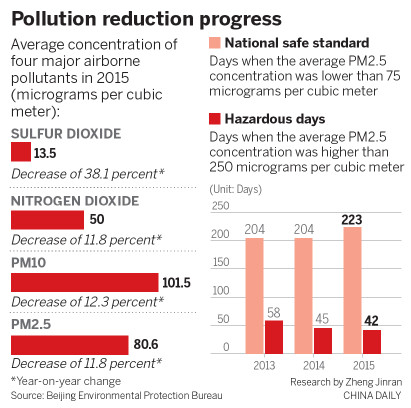
Zhang Dawei, head of the Beijing Environmental Monitoring Center, said the annual readings combine data from good and smoggy days, and that overall the days of heavy pollution have been reduced by one day.
He conceded that heavy pollution days in November and December worsened the air quality dramatically and dragged down the overall performance.
Before smog blanketed the capital at the end of the year, Beijing had managed to cut the PM2.5 daily average readings by 20 percent year-on-year, he said.
Soaring coal consumption and vehicle exhaust emissions have been major factors in the recent smog, the report said.
Beijing slashed coal consumption to 12 million metric tons in 2015-11 million metric tons fewer than in 2012. Also, as part of the restrictions, over 300,000 households in Dongcheng and Xicheng districts, the core region of Beijing, used electricity to provide heat to replace the use of coal-fired boilers.
Beijing is drafting a plan for long-term environmental protection that is expected to be released by the end of the year, he said. He added that by around 2030, Beijing is expected to reach 35 micrograms per cubic meter, at or below which is considered the best air quality.
In addition to the long-term target, the central government has issued a near-term target that might not be easy to reach.
While Beijing has lowered the annual PM2.5 reading to 80.6, it's expected to reach 60 by 2017, as stipulated by the State Council, China's Cabinet.
"It's never easy to cut the PM2.5 readings and improve air quality, but we will further the restrictions on emission of pollutants," said Fang, the deputy head of the Environmental Protection Bureau.


















































